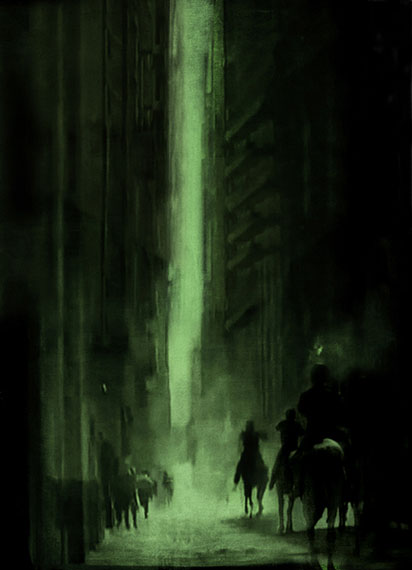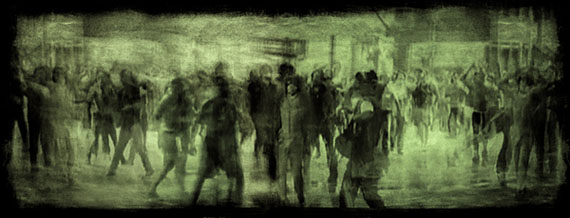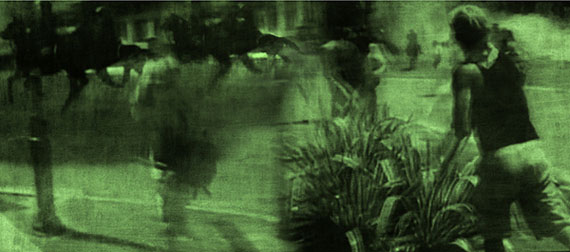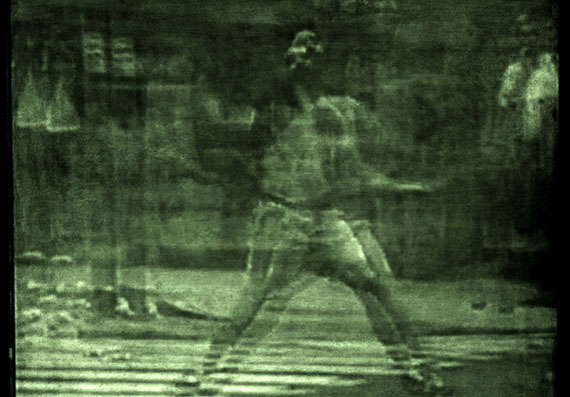
Hugo Aveta »
Ritmos primarios, la subversion del alma
Exhibition: 30 Jan – 22 Feb 2014

NextLevel Galerie
8, rue Charlot
75003 Paris
+33(0)1-44 54 90 88
info@nextlevelgalerie.com
www.nextlevelgalerie.com
by appt

Hugo Aveta
Ritmos primarios, la subversiòn del alma
Exhibition: 30 January to 22 February 2014
Reading time
Internet is like a vast ocean into which we can throw everything and from which we can extract anything. It is our noosphere, the great magma of the entire planet’s mental content. It is from here that Hugo Aveta extracts the videos that he then projects, frame by frame, onto a photographic emulsion, to create the images in this exhibition. One could say that it is alchemy applied to the image, to memory and to time.
Time is Hugo Aveta’s primary material. Condensed, coded, shared time. Time organised by montages whose starting point is an historical document, extracts of reality that Hugo Aveta reconstitutes. The resulting images come from different archival sources. They reveal the artist’s fascination for the particular forms adopted for the recording and cataloguing of experience. It is a fascination that follows, to quote Derrida, “the absolute impatience of a desire of memory.” The memory of the body across the social fabric on which we can read time.
These images arise from combinatory operations that, based on a hypothetical documentary truth, reorganise and multiply the signified. In doing so, they modify its origins and destiny. For the less an image is in focus, the more it is significant. In losing their representative power, images gain the power to evoke and provoke reminiscence. In this visual shift, images acquire a pictorial function and at the same time a kind of ‘night vision’ faculty, like seeing in the dark (similarly to an infra red camera, or a nocturnal animal).
Thinking about photography leads us inevitably to think about ghosts, those entities that appear or disappear according to whether they are called upon or rejected, or who are unable to leave the world because of the strong ties that bind them to it. Who and what exactly are these ghosts who, after so many years floating in the ether, return to us today? They originally derive from the images of the mass protests that shook Argentina during the 2001 crisis, a crisis that lead to the fall of a constitutional government and the beginning of a new era marked by a deeply polarised society, both ideologically and economically. Twelve years later, as popular uprisings sweep countries around the world, Hugo Aveta stirs up this dark, uncertain border between fear and anger, between the desire for freedom and the quest for security.
In the year that witnessed both the fall of the Twin Towers and the collapse of Argentina, the devices that today allow any amateur photographer to film or photograph the most important or the most trivial event, did not yet exist. Yet in the images that Hugo Aveta chooses and treats, there is a certain epic depiction of social upheaval and the courage of the barricades in the face of fierce repression. In his process, Hugo Aveta applies the method of a print lab technician (that nearly obsolete species), but back to front; for the images don’t emerge from the emulsion, they are projected onto it. It is telling that they leave their imprint, their trace, on an unstable, pliant, vulnerable surface: a metaphor for contemporary society.�

Hugo Aveta raises a crucial question: that of the relationship between the visible and the sayable. The artist considers the image to be sensitive, varying in intensity according to the perception of each viewer, but also as a “discourse that codifies a history”, to quote Rancière. An image can thus be read from a personal, social or political point of view.
Hugo Aveta produces the ultimate artistic achievement: distance. We can even say he has found the right distance: between close and far, before and after; he has built this distance on the fringes of the legible and the indecipherable, thus exposing the subversive power of the image. An image in revolt against its own representative role, obsessed by the desire to show that in passing from one instant to another, it is possible to insert the unrepresentable. Nothing is quite as it should be, everything can become what our intuition senses: the tension of friction and/ or the encounter; the pleasure principal and the death impulse; the secret and the explicit, the public and private, the whole and the parts. The images – fallout from a bigger story, fragments of a grand yet incomplete vision – resume the violence between those who hold power and those who confront it; between those who resist and those who defend it. Once the event has faded out, only the shadow remains. These images are the shadow and, with only themselves as references, they enter the cellular memory of the entire social corpus.
The video shown in this exhibition can be interpreted as an extended cry that ends in silence. A silence that is as painful as a non-consensual disappearance. The rise of indignation, in Latin America as elsewhere around the world, is expressed in the form of society’s rebellion against its own creations: the individual against the State, minority communities against big corporations; individuals versus a universal power that governs from the shadows.
One could say that, in his montages, Hugo Aveta proceeds like a therapist seeking to provoke an anamnesis, or the ability of the soul to rediscover the knowledge forgotten during incarnation or birth. This is perhaps why he entitled this work ‘The subversion of the soul’. A subverted soul, rocked to its core, trying to remember the traumatic episodes of a collective history that, like a ghost, will appear and disappear until they are acknowledged in order to be formally banished.
Adriana Almada, 2014 Writer, art critic and member of the AICA International English translation : Miranda Salt
HUGO AVETA was born in 1965 in Córdoba (Argentina). Ritmos primarios, la subversiòn del alma is his first solo exhibition at the gallery. After architectural and cinema studies, Hugo Aveta is devoted mainly to video and photography. His work has been the subject of many solo and collective exhibitions, particularly at Buenos Aires Museum of Modern Art (MAMBA), Museum of Contemporary Art of Rome (MACRO), National Museum of Fine Arts (MNBA), Museum of Contemporary Art of Salta (Argentina), Museum of Latin American Art (MOMAA) in California and more recently at the Curitiba Biennial (Brasil), thus at Photoquai Biennial in Paris. His works today are part of public collections, notably of MNBA, MAMBA, Emilio Caraffa Museum of Fine Arts of Córdoba, MACRO, Musée du Quai Branly and MOMAA.�
